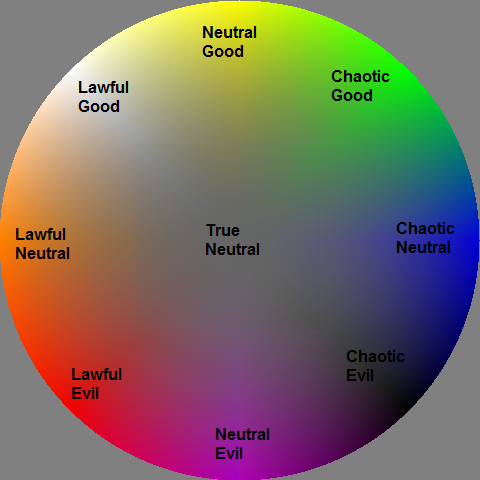The reason why INTP’s occupy, and rightly so, the true neutral position is best seen when you display the alignment spectrum as a wheel. True neutral occupies the hub position because, like everything(?) in nature, form and function are intrinsically connected.

If you look at any of the other alignments on the wheel, each of them only touches 3 other alignments – lawful good, for example, rests sandwiched between lawful neutral on one side and neutral good on the other – the third connection is to the hub, the axle which connects it to the whole. All of the other alignments follow this structure except one (ok, INTJ’s as well).
This is what an INTPs form and function indicate. The circumference of true neutrals’ boundary (the only one that shares the shape of the whole, which is indeed significant) is defined by a portion of all the others. They, of all the MBTI types fully seek the notion of “distinct by definition yet inseparable by nature” (Thus why lawful neutral and lawful good and neutral good lie side by side, they share essential natures, all connected).
INTPs crave understanding, which in this particular example is the realization that as an INTP you occupy a vantage point to simultaneously experience and observe all the other “alignments.” It is in fact, not only who you are but what you do, form and function.
INTPs either intuitively grasp the whole and then seek to build an internally logical framework to “prove” it, or they intuitively grasp the importance of an internally logical framework and then constantly compare reality to it until they then grasp the whole. Since MBTI describes preference and not ability, there are some who are able to do both and then compare the results of those two approaches in order to form an ever superior whole.
This explains both the procrastination and ‘analysis paralysis’ that so often hamstrings the developing INTP mind – they by nature take things apart, examine them, attempt to recombine them in different ways with seemingly disparate aspects of something else (first by comparing it against itself, to see if the thing considered is itself logically consistent before attempting to combine it with something else); seemingly disparate until the connection of the ‘essential nature’ is observed, always with the underlying understanding that there is never enough information to make them truly comfortable. So they wait for more information and then recombine.
Perhaps an example is in order. Take love and hate. Often categorized as opposites, they are actually an instance of two things distinct by definition yet inseparable by nature. How so? Like good and evil they share an essential nature – we see this by noticing that love and hate both share their true opposite: indifference. If they share an opposition they must share an essential nature, in this case the opposite of indifference is attention. So let us compare, does the person in love and the person in hate share the quality of extreme attention? Do their behaviors coincide? The answers to these questions and others like them, I leave as an exercise for the reader.
If you’ve stuck with me so far you might be asking, “So what does an INTP’s search for understanding seek to achieve with that understanding?” Again, the answer lies with its position in the wheel. If you take that wheel and make it three dimensional then the first shape you achieve is a cone, with the hub position now occupying the highest point as well as the central point.
That’s it. That’s the aim. INTP’s seek the highest point that encompasses all other points.
They seek to include and transcend in order to achieve concordant opposition, or true balance. The observer who can not be moved is the one who occupies all points simultaneously. Just like the circumference of the circle which defines true neutral, INTPS are the circle that seeks to define everything so that they may define themselves. This must be a circle (or a spiral, which is merely(!) a circle in three dimensions) a form whose beginning is also its ending, an inside defined by what is outside, the function of paradox, which being the logician, every INTP must learn to solve.
An INTP that has achieved individuation (in my view both necessary and sufficient for enlightenment) is a rare (ok, to be fair, ANYONE who achieves individuation is a rarity) beautiful thing and the reason why so many wish to make the climb and spend some time with that magnificent bitch/glorious bastard absquatulating atop the mountain – the figure who does not move because she occupies all places from the highest most central point. This sentiment was best expressed by Baruch Spinoza – “The highest activity a human being can attain is learning for understanding, because to understand is to be free.”
If you’re a player of dungeons and dragons and you’ve followed my argument so far, especially if you’re an INTP who plays DnD, let me ask you a question, are you or are you not the dungeon master? (My son informs me this is an archaic term, Game Master is the current title sobriquet). If you’ve had multiple play groups, would you agree that the DM’s you’ve had the most fun with were more than likely INTPs (or INTJ)? Aren’t the best ones able to mix all the alignments without losing their core neutrality, which the game truly demands of that role?
If my musings are correct, these are rhetorical questions. One divides by zero by being equal to everything.
